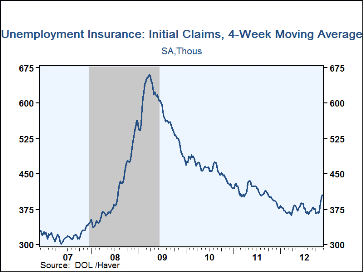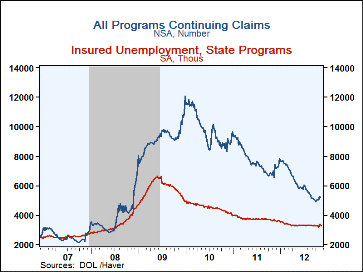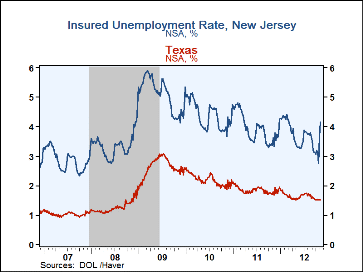 Global| Nov 29 2012
Global| Nov 29 2012U.S. Initial Claims for Jobless Insurance Decline As Sandy's Impact Eases
by:Tom Moeller
|in:Economy in Brief
Summary
Initial claims for unemployment insurance fell again last week as Hurricane Sandy had less of an increasing effect on filings. Claims fell during the week ended November 24 to an expected 393,000 from 416,000 in the prior period, [...]
Initial claims for unemployment insurance fell again last week as Hurricane Sandy had less of an increasing effect on filings. Claims fell during the week ended November 24 to an expected 393,000 from 416,000 in the prior period, initially reported as 410,000. The four week moving average rose to 405,250, its highest in just over one year.
Continuing claims for unemployment insurance in the week ended November 17 fell to 3.287M (-11.5% y/y). The insured rate of unemployment held at 2.6%, up from 2.5% averaged during October. This particular count covers only "regular" programs and does not include all extended benefit and other specialized jobless insurance programs. In the week of November 10, the latest figure available, the grand total of all benefit recipients fell w/w to 5.183M, the highest level since late August. Nevertheless, the latest figure was down one-quarter y/y and was off by more than one-half since the peak in January 2010.
By state, the insured unemployment rate continued to vary greatly with Virginia (1.22%), Texas (1.50%), Indiana (1.53%), Tennessee (1.63%), Ohio (1.68%), Florida (1.74%) and Michigan (2.25%) at the low end of the range. At the high end were Massachusetts (2.60%), Illinois (2.64%), Nevada (2.82%), New York (2.94%), California (2.94%), Connecticut (3.20%) and New Jersey (4.15%).
Data on weekly unemployment insurance programs are contained in Haver's WEEKLY database, including the seasonal factor series, and they are summarized monthly in USECON. Data for individual states, including the unemployment rates that determine individual state eligibility for the extended benefits programs and specific "tiers" of the emergency program, are in REGIONW, a database of weekly data for states and various regional divisions. Action Economics consensus survey estimates are in AS1REPNA.
Labor Market Anxiety and the Downward Trend in the Job Separation Rate from the Federal Reserve Bank of Philadelphia can be found here.
| Unemployment Insurance (000s) | 11/24/12 | 11/17/12 | 11/10/12 | Y/Y% | 2011 | 2010 | 2009 |
|---|---|---|---|---|---|---|---|
| Initial Claims | 393 | 416 | 451 | -1.5 | 409 | 459 | 574 |
| Continuing Claims | -- | 3,287 | 3,357 | -11.5 | 3,745 | 4,544 | 5,807 |
| Insured Unemployment Rate (%) | -- | 2.6 | 2.6 | 2.9 (11/11) |
3.0 | 3.6 | 4.4 |
| Total "All Programs" (NSA) | -- | -- | 5.183M | -26.0 | 7.750M | 9.850M | 9.163M |
Tom Moeller
AuthorMore in Author Profile »Prior to joining Haver Analytics in 2000, Mr. Moeller worked as the Economist at Chancellor Capital Management from 1985 to 1999. There, he developed comprehensive economic forecasts and interpreted economic data for equity and fixed income portfolio managers. Also at Chancellor, Mr. Moeller worked as an equity analyst and was responsible for researching and rating companies in the economically sensitive automobile and housing industries for investment in Chancellor’s equity portfolio. Prior to joining Chancellor, Mr. Moeller was an Economist at Citibank from 1979 to 1984. He also analyzed pricing behavior in the metals industry for the Council on Wage and Price Stability in Washington, D.C. In 1999, Mr. Moeller received the award for most accurate forecast from the Forecasters' Club of New York. From 1990 to 1992 he was President of the New York Association for Business Economists. Mr. Moeller earned an M.B.A. in Finance from Fordham University, where he graduated in 1987. He holds a Bachelor of Arts in Economics from George Washington University.










